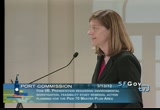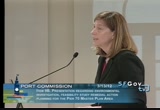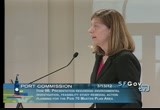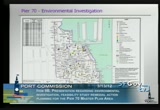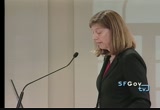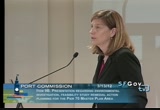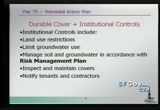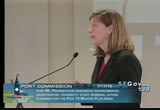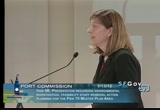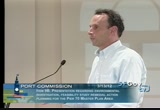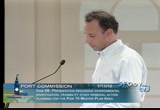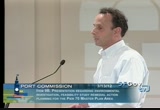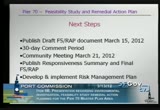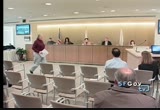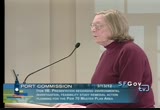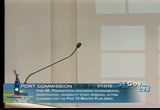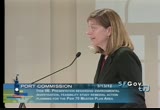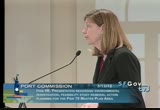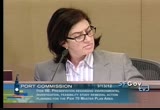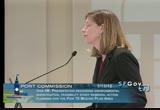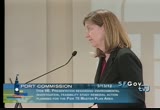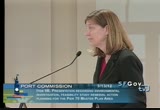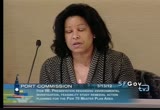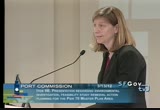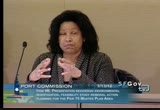tv [untitled] March 21, 2012 6:30am-7:00am PDT
6:30 am
of petroleum. we did not find it in the soil in the same area. the general conclusion about that material is that it does not pose a health risk and is not migrating to the bay, but it excavation were to occur in that area, special handling measures would be applied. and in the southeast corner of the site, the area shown on the slide as the blue polygon, there is an area referred to in the site investigation and the document as the mtp area. this is a portion of pier 70 where the contamination form -- from the formerly manufactured gas plant had migrated from beneath the plant site of north fort and now are present in the pier 70.
6:31 am
in so pg&e has been working closely with the port to delineate the extent to which the manufactured gas plants related contamination has migrated to peer 70. they did additional drilling at the request of the port in january of 2012 to further delineate exactly where the room of waste -- where the plume of voice has migrated. pg&e is undertaking its own feasible study and review action process for the energy related and extending to the contamination before property. so a feasibility study of remedial action plan prior to that little area out and did not deal with it, it becomes a kind of remedial action you would apply to the other contaminants at pier 70 is completely different kinds of
6:32 am
contamination, distribution and the environment, different severity. our remedial action plan does not address contamination, and their remedial action plan will. so the feasibility study, the purpose of the feasibility study would be to analyze various alternatives for remediation as contaminants at pier 70. and following a process that is prescribed by federal and state regulations come analyze the different alternatives to come up with the preferred alternative that forms the basis for a remedial action plan. and so with the feasibility study we started by setting remedial action objectives. what are the goals we want this brevity to achieve? the keep goals are preventing future users' exposure to contaminated soil, preventing
6:33 am
exposure to contaminated ground water or to volatile organic compounds emanating from ground water, and preventing exposure to volatile organic compounds in the air. even though the second two goals are not applicable to this type of contamination, there are pools of the overall remedy. we also wanted to select a remedy that would be very protective and conservative and also, allow the port the greatest flexibility in considering future development at pier 70. we started off by comparing this date at that we had against clean of levels for the three different anticipated uses that we have identified. ultimately we based the remedial
6:34 am
action plan and the feasibility study on achieving residential cleanup goals. we did that so the selected remedy would enable development for any of the three anticipated future uses any where we might want to put them with the napier 70 area. the feasibility study started by looking at a broad range, the redials that might work to address this contamination of the site, and compares those. we came up with a short list of five potentially feasible medial actions. those are no action, which is a hypothesis that is required by the regulation that governs how
6:35 am
you do a feasibility study to state and the alternative analysis as a baseline to compare all the other alternatives. institutional control is a second alternative. institutional controls are administrative or legal measures that can be implemented to minimize or prevent site user exposure to contaminants. an example would be deed restrictions on certain types of uses or mandatory worker health and safety plans for construction workers. alternative #three is combining institutional controls with installation of a durable cover over all of the soil at pier 70. alternative number four is soil excavation and off site disposal, which for the purposes of this analysis we assumed all of the shallow soil at pier 70
6:36 am
would have to be excavated and hauled off by truck to an apartment and fill. the fifth alternative is hot spot removals. excavations of areas where the contamination is concentrated and can be identified is different and more severe than the soil around it. so we evaluated each of those alternatives. nine of federally specified a valuation criteria, and six state-specified criteria, and also, using a fairly recently issued guidance document from the state department of toxic substance control that enables a quality of valuation of how different remedial alternatives themselves and have the
6:37 am
environment. it looks at the sustainability of the remedial action, how much energy it would use, with the greenhouse gas emissions would be from their remedial action community impacts like traffic and noise. so we ran the short list of feasible alternatives through this, of the evaluation criteria, and with the exception of the no action alternative, all of them were determined to be feasible and at least a good short-term and long-term effectiveness. the comparison of alternative to-50 was based primarily on overall protectiveness and cost. alternative no. 3, rated the highest with a rating of very good. the factors that contributed to that ranking were that's
6:38 am
alternative never to come institutional controls, that was determined to be not sufficiently protected. that would not provide a physical barrier between site users and contaminated soil and rely solely on administrative mechanisms. alternative #three, the institutional controls combined with the cap was the highest- rated remedial action. it would provide protections from the environmental contaminants at pier 70 at a relatively low cost. alternative #four come excavation and off-site for -- disposal was found to be affected but also very costly with a cost of 6.7 times more than alternative no. 3 would be, but achieving essentially the same as effectiveness of the end of the day. alternative #five, hot spot removal was found to be neither sufficiently protective or cost
6:39 am
effective, because we could not identify hot spots within the contaminated soil at pier 70, and even if we set an arbitrary limit and said we will remove everything that is 10 times or five times above the cleanup level, you would still be leaving behind a things that have to be capped. it is an unfortunate hybrid of alternative. alternate #3, application of institutional controls was determined to be the best alternative and it is the preferred remedial action plan for the site. durable covers would include buildings, streets, sidewalks, plazas, paved parking areas, anything that would prevent an effort in contact with underlying contaminated soil. new landscaping would be a
6:40 am
durable cover. any sort of armor or stabilized shoreline treatment could meet the standards of adorable cover. for example, agio textile fabric or a seawall or some other form of engineered shoreline treatment. institutional controls include things like land use restrictions. an example might be a deep restriction or site-specific activity restrictions. for pier 70 be activity restrictions would be things that probably would not happen at pier 70 any way like rolling produce for consumption in native soil or allowing livestock grazing and native soil. ground water could not be used for domestic water supply, which at pier 70 it is failing ground water, and that would not
6:41 am
be happening. ground water use would be limited to watering during construction. soil and groundwater would have to be managed in accordance with our risk management plan. the risk management plan is a key component of the remedy. a risk management plan will be developed to support consultants in conjunction with the water board. we will be developing a plan that describes all of the ad industry the measures that need to be in place at pier 70 in order to ensure the long-term integrity of the cap and that the site is managed in accordance with things like storm water pollution prevention, thus control, and worker health and safety protections. -- dust control, and worker health and safety protections. we would have a monitoring program in place to insure the
6:42 am
integrity, and a program to require notification of tenets and contractors about the existing conditions and the requirements under the risk management plan. so one thing i wanted to mention at the beginning is that the san francisco bay regional quality- control board is our primary regulatory agency overseeing our work at pier 70. we also have regulatory oversight from the city and county of public health, bureau of and our mental health, and they are the group that enforces the local requirements for socle characterization before construction, risk-management planning and construction with -- bureau of environmental health, and they are the group that enforces the local requirements for soil
6:43 am
characterization before construction, risk-management planning and construction. joining me is mark johnson. both of us are available to answer any questions you might have. >> good afternoon. i'm marc johnson from the regional water board. i work in the toxic cleanup division, pretty much specifically working on redevelopment projects like you're 70. and i am also working on the adjacent control power plant, so it makes it more convenient. looking at the proposed remedy for pier 70 come it is highly protected. there will be no exposure to the effect of soil that is there now post-development. that is the best way to go. no exposure, no residual health
6:44 am
component. construction worker exposure as the manage this can be managed through a health and safety plan. procedure that is pretty standard and simple. one nice thing about the proposed remedy is there is two ways to address here 70 is either remove the soil or be bought it in place. if you remove the soil, there are buildings on top so you could damage or demolish the historic buildings. so this is friendly to the buildings that are there. it has a very low carbon footprint as compared to hauling off several hundred thousand yards of soil and bringing in that much soil. it can be implemented during the redevelopment quickly. it will not really slow down the redevelopment. it is not extremely expensive. it can be done consistent with the redevelopment, and it is pretty much consistent with a lot of other projects we're
6:45 am
working on. i am finishing up a park project that was a former firbun dump. it was a little island on the edge of the bay that is now being converted into a park. we're living a 2 ft. soil cut across the entire site and preventing exposure and preventing any health risk. a work on a project and grand marina that is now a subdivision with a single cap over the surface. that have contaminated soil spread over the surface and a few feet of soil protect the future residents. other sites in and rebemryville. we're about ready to take to the public for public comment. we will hold a community meeting later this month. other than that, i see carol cover pretty much everything on this. -- i think carol covered
6:46 am
pretty much everything on this. >> so next steps, we are publishing the draft document on march 15. that is thursday of this week for a 30-day public review and comment perid. od. a community meeting on the evening of march 21 in association with their advisory group meeting, but also have made very broad notification to all of the residents and businesses in the area and people who attended previous meetings or express previous interest in environmental conditions. following the 30-day comment period, the water board will receive the public comments and working with the port staff and port consultants will come up with a response document that
6:47 am
documents the responses we've gone and how we will incorporate them in the final draft. we will publish the responses and begin development of our risk management plan. so if you all have any questions -- president whoo ho: public comment. corine woods. >> good afternoon, corine woods. the proposed remedy for pier 70 is very much like what we did and are doing at mission bay, cap and cover. it's working.dus dust control has never worked, because no one is enforcing it.
6:48 am
we are fine, so far. we of work with mark on mission bay, and he knows the area and the contaminant and the issues, and i feel very confident that whatever plan they come up with will be affected and cost- effective. my only concern is if you discover hot spots after the fact that you may have to dig them out, because if there is something that could be migrating to the bay that has not come and i am amazed there is an inch of soil that has not been tested, but if you do find something later, you may have to pull it out and get rid of it. we did a long districts -- 16th street corridor in mission bay, because we have former oil depot where ships used to come in and bring oil and that have to be dug out, because there was
6:49 am
just too much and there to leave it in place. we were very worried about migration to the bay of that. otherwise, i think this will work. thank you. president whoo ho: any further public comment? and the questions? -- any questions? >> i have to say how impressed i am with corine woods. it reminded me how lucky we are in san francisco to have citizens to pay attention to so much of the specific action and provide beneficial and pithy information to all of us that need to hear from the public. i wanted to thank you as always for your comments. a couple of questions. some of this is answered in part
6:50 am
through the agreement that was reached with the department of defense, but is there any further funding that is likely to come from the department of defense, given they have ownership over the site at some point and are responsible for some of the contamination, or did we reach the maximum ability to get funding for the cleanup from them? >> i would say our ability to get federal funding from the department of defense is probably more related to the climate in congress with respect to federal appropriations than the reality of what we encountered at pier 70. >> once you have touched on the ownership of lands and divided the contamination, there is ongoing responsibility for cleanup. to go it easier is curious -->> indeed there is.
6:51 am
if there was a component of the release of country to the navy and hold them responsible for, we certainly live want to do that, so we would take a look at that. >> the same holds true if there were underground storage tanks? to go historically there were underground storage tanks. to the best of our knowledge they have been identified and removed. the risk management plan will include a section for an anticipated -- unanticipated of storage tanks and hot spots. >> do we have any prior owners that may provide funding? >> the former site owners and occupants are mostly no longer in existence. although several years ago staff
6:52 am
undertook this forensic investigation of general liability policies for those former owners that might respond to environmental claims. that is something we look up and it will look into further if we need to as well. >> my understanding is there will lobby in the residential development in the site, but i read that the cleanup will be to a residential standard. >> we held the residential standard again to be as productive as possible, and also to allow flexibility in the event the residential uses far wanted. >> is being cleaned up to the residential standard? >> appear 70 master land-use
6:53 am
plan does anticipate residential development. we are considering that a possible outcome. >> i want to make sure it will be done to the residential standards? even depending on the america's cup? >> that is exactly true. the remedy would be protected under a regular use of scenario. it is going to remain in place and manage in a way that would. i just want to make sure we are not doing light industrial or other standards. >> we wanted to enact -- and that the remedy that would use the broadest use possible option. >> as always, do we have something in place that will address some of the potential migration? i think we have some of the same problems that we might
6:54 am
encounter other things. are we anticipate that? take a look that is also something that will be addressed in the risk management plan. a good example of that is in the mission bay development area risk-management plan. there is our requirement when you are constructing new utility corridors you back fill those with material so you're not creating a new conduit. i cannot swear that will be a measure, but it is certainly the kind of thing we would be looking at. also, since the primary issue of concern here is soil, we will be focusing on ways to prevent erosion on unprotected shore lines. that is another issue of contaminant migration we will be looking at. >> speaking of soil use, one of
6:55 am
odd facts is the serpentine is that contains naturally- occurring asbestos. >> it is commonly throughout california. naturally-occurring asbestos is found in soil. interestingly, we did not find significant concentrations of asbestos in the soil at pier 70. we found very high concentrations of the metals that are indigenous to serpentine rock. arsonist, zinc -- there is a list of laundry-recurring models that we did find. -- there is a laundry list of recurring metals that we did find. >> it sounds like a thorough approach to a problem. thank you. >> what remedy will happen with of paah's that have
6:56 am
leached from the plant? >> pg&e is in the process of starting the feasibility study. they have done at some events scale, all side of the laboratory tests on different remedial alternatives that might work on this manufactured gas plant related contamination. whenever remedial alternative they come up with will include the portion of the contamination that has extended to meet the port property, but we do not know what that is. we have been working really closely with pg&e team working on this remedial action plan for a feasibility study. if the commission would be happy from -- happy to hear from them, i would be happy to get them? .
6:57 am
>> i know there were several options and i thought we were going to use option 3 throughout the whole site, but if there are hot spots, why are we using a combination? if we're going to the residential, other than assuming someone will not grow something actually bring it to a standard where they can grow something on a small piece? i am wondering why we're doing the same thing throughout the site but not making necessary -- >> right. 'the first thing about hot spots, we did not identify a hot spot for the investigation we did, but that does mean there is not something out there on a smaller scale that we were looking that might be
6:58 am
encountered during future development. so the risk management plan will address the potential that one might encounter unforeseen conditions during construction and will establish management measures and response actions to be taken in the event there is a hot spot and something identified, potentially an unknown underground storage tanks or concentrated contamination of some other kind. we have not written a hot spot problem off completely, it is just we are not able to identify it so far. with respect to residential, if that sompointaat some point ours found, we could always revisit it and look to amend the remedial action plan for a
6:59 am
project that specific purpose, but we really wanted to adopt remedial action plan and now that we thought would be protected and cost-effective for all of the things we anticipate might happen so we would not have to reopen it in the future. it does not mean that we could not. >> [inaudible] >> sure. absolutely. the standard would be if you're going to have a yard, it is going to be imported soil on top of native soil, and there would be a barrier to prevent kids, trees, anything else from penetrating through the clean cover into the contaminated material. does that answer your question? >> thank you.
194 Views
IN COLLECTIONS
SFGTV: San Francisco Government Television Television Archive
Television Archive  Television Archive News Search Service
Television Archive News Search Service 
Uploaded by TV Archive on

 Live Music Archive
Live Music Archive Librivox Free Audio
Librivox Free Audio Metropolitan Museum
Metropolitan Museum Cleveland Museum of Art
Cleveland Museum of Art Internet Arcade
Internet Arcade Console Living Room
Console Living Room Books to Borrow
Books to Borrow Open Library
Open Library TV News
TV News Understanding 9/11
Understanding 9/11